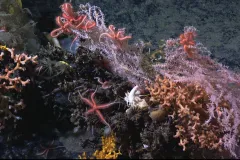Seamounts: Underwater Oases

Thousands of seamounts—most of them undersea volcanoes—tower above the muddy seafloor. They provide something hard to come by in the deep ocean: a solid surface to cling to. Corals, sponges, and other marine animals attach themselves in dense colonies to seamount slopes. As the animals grow and reproduce, they create three-dimensional structures that provide homes for other creatures. Crabs, sea lilies, and brittle stars climb aboard to gather food. Currents well up and swirl around, serving up a constant supply of nutrients and plankton. There may be 30,000 seamounts in the Pacific Ocean alone. Less than 1% have been explored. Many are separated from one another by long distances. Are seamounts like islands, each with its own unique fauna? That and many other questions remain to be answered.



